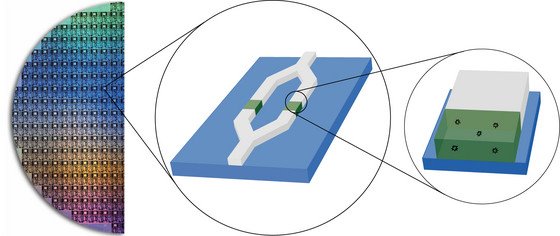Sep. 29, 2006 Research Highlight Physics / Astronomy
Using defects to improve quantum bits
Naturally occurring defects in quantum devices could be used to improve their performance
 Figure 1: Microscopic defects in quantum circuits could themselves be used as quantum devices. The circles show progressively magnified views: an electronic chip (left), an artificial qubit (middle) and microscopic defects inside the qubit (right).
Figure 1: Microscopic defects in quantum circuits could themselves be used as quantum devices. The circles show progressively magnified views: an electronic chip (left), an artificial qubit (middle) and microscopic defects inside the qubit (right).
Naturally occurring defects in superconducting devices are usually thought of as an annoying source of noise, or imperfections that must be minimized.
Now, a team led by Franco Nori, a physicist at RIKEN’s Frontier Research System, Wako, and the University of Michigan, USA, has shown that these defects can be used to perform quantum computing tasks1.
To advance the speed of computers, researchers have been trying to fabricate superconducting devices to do quantum computations. These tiny devices are called quantum bits—or qubits for short. Just as ‘bits’ are the smallest unit of information stored in a classical computer, qubits are the basic units of quantum information. A qubit can be thought of as an oscillator where the information is stored in the exact form of the qubit oscillations. Any disturbance to these oscillations, such as electrical noise from a fabrication defect, degrades the information stored in a qubit in a process called decoherence.
Defects in artificial qubits have posed a major obstacle to performing calculations (Fig. 1). If a defect oscillates at the same frequency as the qubit, they can communicate at that frequency. Thus, the defect can quickly absorb the information from the qubit, perturbing the qubit oscillation, and causing very fast decoherence. Scientists therefore thought that the devices must be made as clean as possible to reduce the number of defects. Then Nori proposed the new idea that if these defects can keep oscillating without disturbance for a very long time, they could also be used as qubits.
The defects do, in fact, have some advantages over the artificially fabricated qubits. As the defects are usually microscopic, they are well-isolated from disturbances, unlike the entire device that is essentially immersed in a sea of electromagnetic noise. Furthermore, in a single artificial qubit, it is typical to find tens of `good' defects that can oscillate without dissipation long enough to be usable.
Nori's team demonstrated that during fabrication full control of defects, which are uncontrollable, is not required. Good access to the qubits is all that is needed, and this can be achieved through the artificially fabricated device. "Think of atoms," says Sahel Ashhab, a member of the RIKEN team, "we do not need to spend any effort making them, and each species has different properties from the other; yet we can use them to do all kinds of quantum-mechanics experiments.”
References
- 1. Zagoskin, A. M., Ashhab, S., Johansson, J. R., & Nori, F. Quantum two-level systems in Josephson junctions as naturally formed qubits. Physical Review Letters 97, 077001 (2006). doi: 10.1103/PhysRevLett.97.077001
